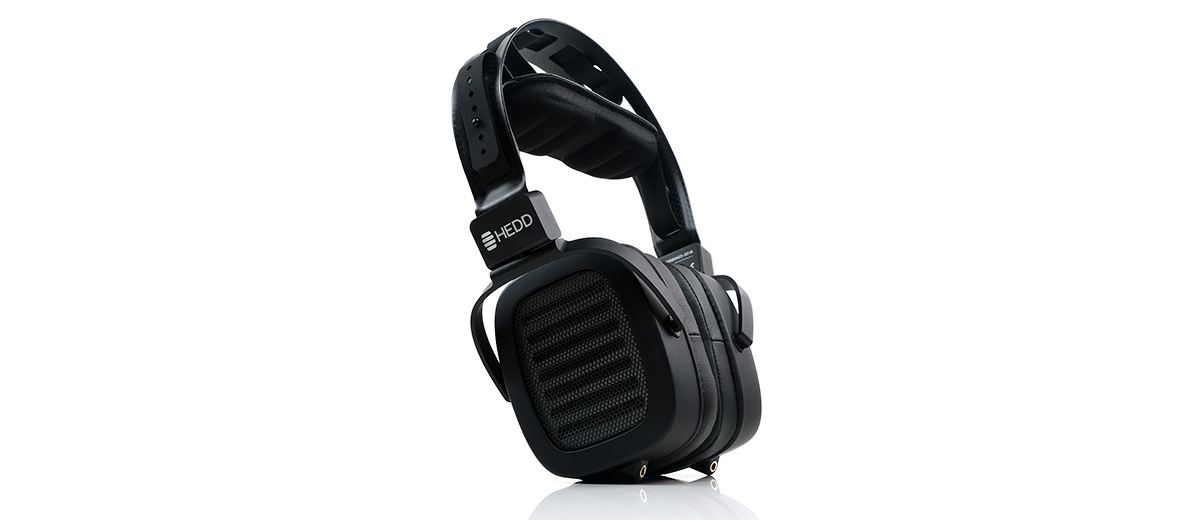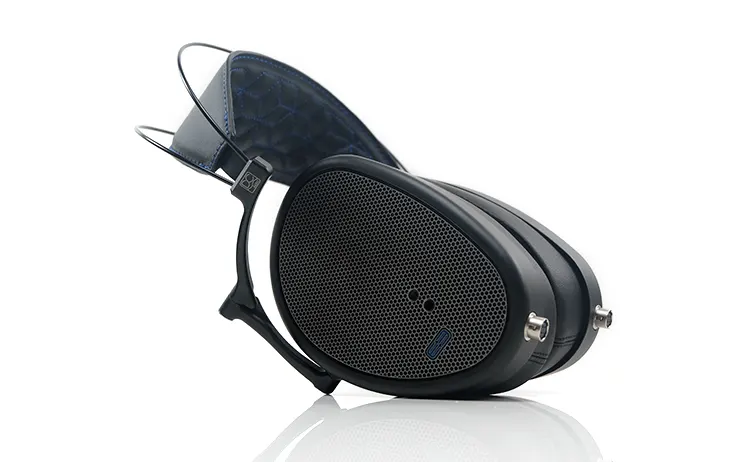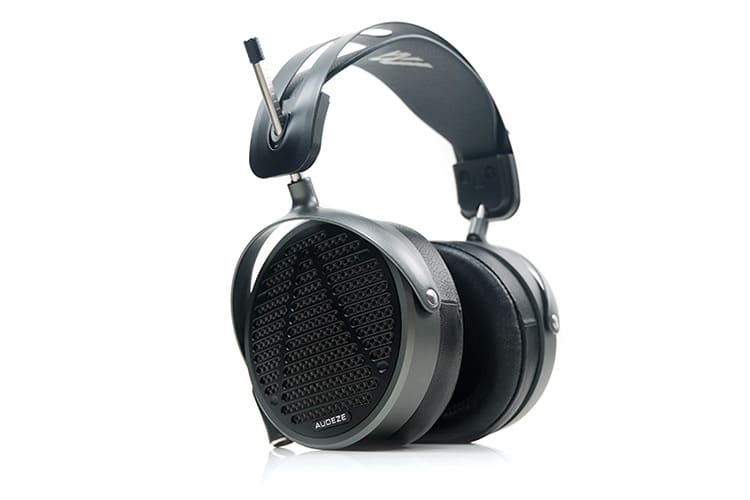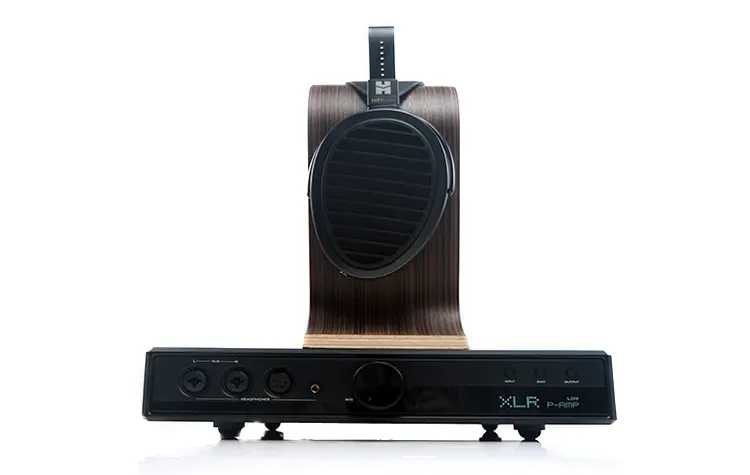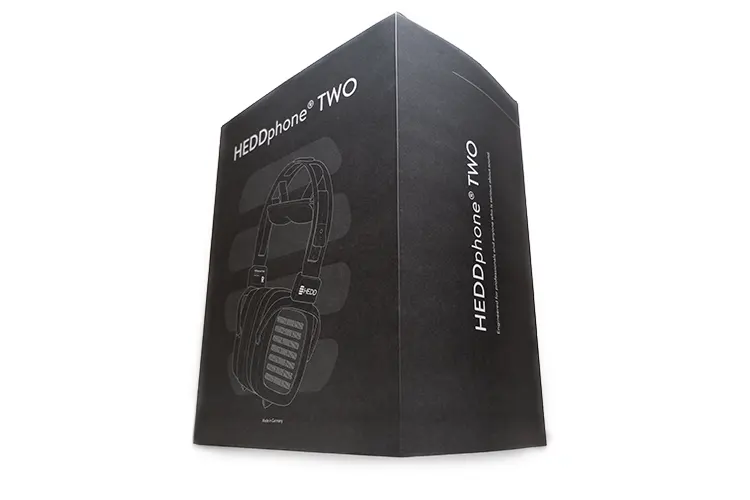Selected Comparisons
The following comparisons to the HEDD Audio HEDDphone Two were completed with a Ferrum OOR/HYPSOS and HIFIMAN’s Prelude for our main amplification units.
Our sources included a Cayin Mini-CD MKII as well as the HIFIMAN Serenade, and Holo Audio Spring 2 Wildism Edition DAC for both physical and digital audio formats.
Dan Clark Audio E3
The Dan Clark Audio E3 was launched late last year and we just completed the full review last weekend so it’s still ‘hot of the press’ so to speak. You can read our full review of the E3 here.
Technical
This is a closed-back planar headphone which might seem a surprising comparison given the HEDDphone Two is an open-back design. However, DCA’s implementation of the dual port system on the cups combined with the AMTS technology makes this a very open-sounding closed-back.
With pleated ribbons and bellow-like articulation, the AMT driver of HEDDphone Two operates quite differently from a standard planar design.
However, the E3 V-Planer’s knurling design also has a diaphragm with some unique folding characteristics. The intended result is somewhat similar to the pleated AMT ribbon, i.e., pushing more air and improving the air movement efficiency.
Mass-wise, however, I presume the HEDDphone driver is lighter, and peering into the cup I would presume it’s a smaller driver than the one inside the E3. The variable folding techniques from HEDD’s VVT technology might also further differentiate their approach from DCA who do not mention if their diaphragm Knurling process is similarly applied.
Another shared characteristic is their efficiency, or perhaps lack thereof. The E3 driver is rated at 27Ω impedance and -90 dB/mW sensitivity which is only just marginally more sensitive than the HEDDphone Two’s 41Ω and 89 dB /mW benchmarked numbers.
Both of these headphones are going to require decent current and gain headroom from any matched amplifier you want to pair them with.
Design
Very different and very unique design approaches. The E3 aesthetic is minimalist compared to the heavily engineered and muscular styling of the HEDDphone Two. The E3 nitinol headband is so low-profile you probably wouldn’t notice that the cups are bigger than the HEDDphone Two’s.
Not only that, but the folding capability of the E3 makes it far more discreet for travel, even though the HEDDphone does come with an excellent carry case.
Durability? I would say even given the carbon fiber of the HEDDband is quite a pliant construction. For the yokes and swivel, well it is hard to tell given both are quite new but the DCA design has yet to fail for me in using these types of headphones continuously for the last few years.
Doffing my cap off to the HEDDphone Two for the massive weight reduction over the V1 which greatly improves wearability but it’s a challenge to beat out the E3 in terms of comfort.
The ovoid cup, nitinol headband, and strap system used by DCA for the E3 combined with the almost 100g weight saving makes it a winner for comfort against almost any flagship headphone out there save for Meze and some HIFIMAN models.
Where the HEDDphone Two comes into its own is the flexibility of the HEDDband to account for a wider range of head sizes and individual clamping pressure preferences.
You do not get that same level of choice with the E3 headband but at the same time, the E3 fitting perhaps negates a lot of the reasons to fiddle with it unless you have an odd-shaped head.
Performance
The E3 does sound roomier courtesy of more presence from 100Hz down to 20Hz on the lows and greater elevation from 5-10k on the other side of the curve. I think beyond that the two are fairly even for the ‘ultra-highs’.
The HEDDphone Two brings more to the upper bass through the lower mids with more elevation almost up to 2k. Anything that falls in that region resonates more strongly on the HEDDphone Two whereas on the E3 it’s a little lighter with neutral imaging.
The E3 is more ‘Harman-friendly’ from 2-5k, however, the HEDDphone Two brings more density and body to the mids despite having a somewhat relaxed curve for vocal and instrumental positioning.
Tonally, E3 is comparatively cleaner with more timbral contrast through the mids and less warmth in general. It does, however, reach deeper and offers a stronger fundamental.
Percussion in particular highlights the differences between the lows on each headphone. A good example is Kelis’s “Game Show” recording from her Kaleidoscope album which has hard-hitting kick drums, magnified by a sparse mix.
With the E3, the drums were positioned lower, further away from the vocals, reaching deeper and decaying faster. With the HEDDphone Two, the imaging was pushed up a bit closer, the decay was longer with more warmth and punch but also less depth and high click.
Switching to the top side using the same track around 4.15 minutes into the recording is a passage of xylophone notes. The E3 played the passage a little narrower on the X-Axis but a little higher in positioning with a cleaner, perhaps more accurate tone.
The HEDDphone Two played it wider but closer positioning-wise and with more body and warmth. In this instance, I felt the HEDDphone Two coloration and firmer presence were more pleasing sounding.
Audeze MM-500
The Audeze MM-500 was launched in mid-2022 with our review shortly after and remains a popular model to this day among Audeze fans and Studio pros. You can read our full review of the MM-500 here.
Technical
Both are open-back headphones designed to appeal to studio pros and not just the ‘audiophile masses’.
The MM-500 is primarily a pro or studio planar headphone tuned in collaboration with Grammy Award winner Manny Marroquin. Whereas the HEDDphone Two could be interpreted as the portable extension of the company’s studio monitor heritage.
It is a similar difference though to the E3 comparison, i.e. AMT versus planar. The Fazor-equipped MM-500 does dance a little with its more illustrious flagship sibling, the LCD-5 though it does not steal all the limelight from its driver design.
The ‘stolen’ is the 90mm driver size combined with the LCD-5’s more efficient and lower impedance single-sided Fluxor™ magnet array, (14 magnets in total). However, the MM-500 still uses the Ultra-Thin Uniforce™ diaphragm similar to the LCD-X and the LCD-XC 2021.
Like most of their recent headphone iterations, Audeze has ever so slightly lifted the ear pad ring which moves them a little further from the main MM-500 housing to enhance the ventilation performance.
You will find amplification matching significantly less of a challenge with the MM-500. Compared to the HEDDphone Two’s 89 dB/mW rating, the MM-500 is more sensitive at 100 dB/mW making it easier to drive a wider range of amplifiers.
Design
As with the E3 comparison, the MM-500 is a much smaller headphone and around 55g lighter. Aesthetically it’s a combination of the new LCD-5 form factor with the older LCD lineup.
The materials include traditional spring steel, machined aluminum, and polished acetate enclosures as well as the classic thickset and very plush LCD leather earpads.
It’s a simpler design compared to the beefy HEDDphone Two which dominates the table when placed beside the MM-500. There will be some who prefer the simplicity of the MM-500 when handling them.
For comfort, however, there isn’t a huge amount of difference save for the small additional weight of the HEDDphone Two.
I do think you are going to be more aware of the HEDDphone Two on your head because of its comparatively grandiose form factor and the crinkle sound from the AMT driver.
However, the varied clamp and positioning options from the HEDDband and the relatively fixed and tight clamp of the MM-500 make this more of an even playing field.
I also think Audeze needs to up their game a little when it comes to cable options. The MM-500 comes with a relatively well-designed and easy-to-use braided 20AWG OCC copper cable. However, it is single-ended only meaning anything else will require you to fork out between $175 to almost $600 for some additional balanced options.
The HEDDphone Two has all of that inside the box. Be it single-ended or balanced you can choose to go with either right from the moment you start using them. Advantage HEDD.
Performance
I think if you like the MM-500 you are going to take to the HEDDphone Two presentation. They have a degree of overlap in terms of general mid-centric pitch and fairly rounded staging quality. However, I would stop short of saying they sounded similar because there are a few differences in their tuning that set them apart.
The first is the bass response. Overall, both are relatively flat but the HEDDphone Two rolls off a bit more at 60Hz down to 20Hz whereas the MM-500 similarly fades but retains a bit more energy with less dB drop.
The resulting difference is just a bit more weight and impact from the MM-500 but it’s by no means a huge gap. The HEDDphone Two does seem to resolve a bit better than the MM-500 throughout and on the lows this is reflected in a better level of detail in drum and bass guitar note texture.
The second deviation is the MM-500 2-4k range which is much more pronounced when compared to HEDDphone Two. It has the effect of pushing everything that pitches in the region front and center.
Both vocal and instrument can thus dominate recordings and is something that can both excite and fatigue in equal measure with the MM-500. The HEDDphone Two pulls them back a bit to create a more relaxed effect.
The final difference is the lower treble from around 5-8k. You get more lift here from the MM-500 compared to the HEDDphone Two which gives them a generally more neutral coloration. The HEDDphone Two doesn’t exhibit the same level of energy here resulting in a warmer more rounded tonal quality through the mids.
HIFIMAN Arya Stealth Magnet Version
The HIFIMAN Arya Stealth Magnet Version was launched in early 2023 with our review coming in April of that same year. Its $1599 SRP is heading in the direction of the HEDDphone Two but currently, HIIFMAN has it at a special price of $899 which some might see as a bit of a bargain.
Technical
Completing our trifecta of planar comparisons is the Arya Stealth Magnet Version. This is an open-back planar driver incorporating the company’s dual-sided Stealth magnet design combined with Hifiman’s nanotechnology for the diaphragm.
If there is a commonality in the driver design it’s the quest for low mass and speed. HIFIMAN’s long journey to trying to get that diaphragm as thin as possible means the Arya comes equipped with NsD technology which stands for NEO “superman” diaphragm and measures at the nanometer level in terms of thickness.
Now, I am not sure how thick the HEDDphone Two AMT Kapton polyimide film is when compared to the HIFIMAN NsD diaphragm but the intention is much the same, and that is fast and precise movement with an eye for micro-detail retrieval.
The Arya Stealth is rated at 32Ω and 94 dB/mW so whilst not that efficient it is more sensitive than the 89 dB/mW rated HEDDphone Two.
That may mean a few more amplifiers fall within the Arya Stealth crosshairs in terms of power though tonally I am a little fussier with the matching compared to the HEDDphone Two.
Design
The Arya Stealth is another cup-centric design much like the DCA E3. What I mean by that is that the visual is dominated by huge cups and not much else above the yoke and pivot block. The HEDDphone Two’s more elaborate HEDDband system gives them a taller form factor though the cups are quite a bit smaller.
Both have uniform black finishing to them but I would say the HEDDphone Two has the better materials and sturdier build.
HIFIMAN build quality is not as bad as some might suggest with this ovoid form factor probably their most stable version down through the years. It still feels somewhat delicate compared to the HEDD audio design and with far less flexibility also in the headband.
The Arya Stealth is 145g lighter and those big ovoid inner pad openings combined with a moderate clamp and pressure strap make it far more comfortable to wear out of the box compared to the HEDDphone Two.
It does not have all the HEDDband adjustment options and I dare say the HEDDband is going to last a lot longer with any sort of rough studio use. However, at least in my experience, you do not need much adjustment with the Arya Stealth fitting. It’s a great fit period.
Cable-wise the reverse is true. The Arya Stealth 1.5m single crystalline copper cable is very dated-looking and only comes in a single-ended termination. It can also be quite a memory retentive cable and a bit stiff straight out of the initial roll.
The HEDDphone Two cable system is more amplifier-friendly, more user-friendly, and handles like a champ. It also looks better with superior finishing combined with those useful pigtail adaptors.
Performance
If you want an expansive soundstage with a lot of height, air, and a clean highly separated presentation then the Arya Stealth Magnet Edition has a clear advantage over the HEDDphone Two. In some ways, it makes the Two sound slightly compressed at both ends of the spectrum.
However, if you want more body, more slam, and generally a richer tonal quality, especially through the mids, the HEDDphone Two is the better pick. In its way, it makes the Arya Stealth sound too pristine and ethereal to convey the necessary authority for some rock and pop recordings.
Where is this all reflected in their respective tuning? Well, the Arya Stealth does have a little more sub-bass presence below 50Hz and you will hear that when it’s called upon.
However, beyond 100-150Hz and up to 2k, the HEDDphone Two offers more presence, body, and warmth. You can hear that in all manner of instruments from drums, guitar plucks, and vocal performances. It simply rounds the richer and smoother of the two headphones over that region.
From 2k onwards the Arya Stealth exhibits more energy and elevation but the flatter upper bass and mids mean it doesn’t carry any weight with it. Hence the ethereal description.
It’s forward but lacks body giving it a lighter airier tone. It’s great for imaging precision, a perception of speed and sparkle, and certainly percussion has more bite when compared to the HEDDphone Two.
The Arya Stealth can make you wish the HEDDphone TWO had a bit more energy in the equivalent range just to add some presence to its percussion. However, at the same time, the smoother sound and better midrange body make it more enticing and engaging for most vocal performances save for maybe some classical recordings.
Our Verdict
The HEDD Audio HEDDphone Two doesn’t buck the pitch of the original HEDDphone. It still creates a very different and cool proposition to what is currently out there in the headphone market.
However, the looks have radically changed as also the sound. This is a flatter more muscular sound signature with a heavier emphasis on midrange excellence. It works a charm with metal and thrash and anyone looking to get up and close to guitars in their audio listening.
It also looks more in line with the HEDD brand styling, weighs less, and offers a much wider range of fittings courtesy of the innovative HEDDband system.
These types of traits jive beautifully with my listening preferences and subjectively I will be using these headphones a lot for some of my classic rock and metal listening.
Where it is weaker is the lack of presence at both ends of the spectrum so it might not be your classical music champ. It is not as roomy sounding nor does it convey the same splash of sparkle and air as some of its similarly-priced competitors. Horses for courses here for listening preferences so choose with that in mind.
Overall, this is a clear step up from the original in terms of technical capability and comfort levels and pleasingly the price is unchanged since the V1, which is a nice bonus in this day and age.
HEDD Audio HEDDphone Two Specifications
- Driver: AMT with full-range VVT® technology
- Frequency Response: 10 Hz – 40 kHz
- Efficiency: 89 dB /mW SPL
- Impedance: 41 Ω
- Power requirements: Minimum 200mW, recommended ≥ 1000 mW
- Connection: Symmetric 3.5mm
- Cable: Kevlar-infused, braided.
- Pads: Faux leather ear pads and heat cushion.
- Weight: 550g

